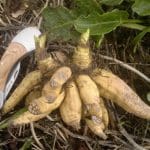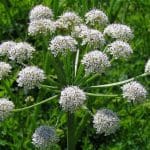HEMLOCK WATER DROPWORT / SPRING / SUMMER / AUTUMN / DEADLY
COMMON NAMES
Hemlock Water Dropwort
BOTANICAL NAME
Oenanthe Crocata
SCIENTIFIC CLASSIFICATION
Kingdom – Plantae
Order – Apilaes
Family – Apiaceae
Genus – Oenanthe
PHYSICAL CHARACTERISTICS
Root – Large carrot like tubers growing in bunches.
Stems – Hairless but grooved like celery, they have a hollow centre. Leaves – Green shiny leaves, the leaf stem branches off in opposite pairs half way up the stem. Each branch looks like a mini version of the whole shoot, with a stem and leaf stems branching off in opposite pairs, which are 2-4 times pinnate (splitting off in pairs of leaves or stems). The leaves are much more rounded than that of Cow Parsley or Poison Hemlock, but still has a toothed edge.
Flowers – The flowers grow from a central stem. The flowers grow in an umbel (this is part of the umbellifer group). There 12-20 thin stems growing from the top of the stem which at the top are 15+ more thin stems each with a single flower with 5 boomerang shaped leaves around a creamy off white centre and long white anthers with a black tip. If you turn the flower stem upside down the stems look like the spokes of an umbrella (umbrella-umbellifer is how I remember it). Seeds – The seed heads are spiky clusters of small individually shaped teardrop and brownish black seeds.
KNOWN HAZARDS
The whole plant is deadly toxic. The roots are the most deadly, containing a powerful neurotoxin called oenanthetoxin, which triggers spasmodic convulsions, usually followed by sudden death. This plant has caused more deaths in the UK than any other plant.
COULD BE CONFUSED WITH
Celery, flat leaved parsley.
RANGE AND DISTRIBUTION
Europe, including Britain, though absent from the far north, to W. Asia.
HABITAT
Damp places, ditches, along rivers, canals and streams, surrounding ponds and lakes.
EDIBLE USES
This plant is deadly poisonous. Do not eat any part of it, and seek immedeiate medical attention if someone has done this by mistake!








